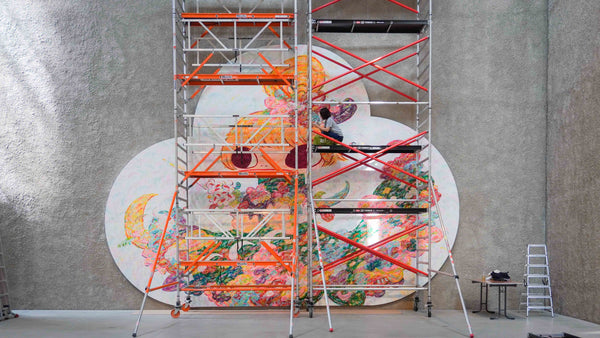ZSÓFIA
KERESZTES
Embracing
Duality
30 October 2023
We accompanied Zsófia Keresztes during her preparations for the exhibition IN ETHYLENE ARMS, which is on view in the Nave of St. Agnes. Known for her fondness for creating large-scale sculptures out of pastel-colored glass mosaic tiles, the Hungarian artist has developed a characteristic visual language balancing vulnerability and vigorousness. Her shiny sculptures are reminiscent of organs, flesh, and fantastical, flamboyant figures, full of associations with mythology, philosophy, and art history. IN ETHYLENE ARMS revolves around the apple as a metaphor for femininity and motherhood and transforms the Nave into a garden of earthly delights. Catch a glimpse into the artist’s creative process and watch the creation of her characteristic sculptures.
Zsófia Keresztes established herself as a shining light within the Hungarian art scene when, in 2017, she made a decision that eventually would elevate herself onto the next step of her artistic career: having worked with textiles before, Keresztes was in search of a new material to cover her large surreal sculptures with. As the artist draws inspiration from the glossy membrane of the human inner organs, she finds glass mosaics to be the perfect addition to her anthropomorphic sculptures. The shiny glass tiles allow associations with flesh and surreal identities, both virtual and real. Using a deceptively cheerful palette of pastels, ranging from peach and rosé to turquoise and light green, Keresztes marries sensibility with the grotesque, thereby presenting herself as a master of mixed signals. Keresztes’ sculptures seamlessly blend pleasure and pain, vigorousness and vulnerability into one another, addressing ideas around intimacy, empathy, femininity, and selfhood in a digital age.
For her recent work, Zsófia Keresztes switched from depicting surrealistic bodies to showing apples in their various states of metamorphosis, associating cultural-historical aspects with the fruit. In her solo exhibition, IN ETHYLENE ARMS, the artist plays with the symbol of the apple in eight large-scale sculptures, turning the Nave of St. Agnes into a garden of earthly delights and suffering. For Keresztes, the apple is a metaphor for femininity, motherhood, and maturity, which are linked to a search for balance between oneself and others in the process of growing up. Her sculptural works seem to be perfectly symmetric, yet they reveal a slight imbalance on closer inspection, a detail that refers to the restlessness and inner conflict underlying Keresztes' works. This conflict is not only visible in the contrast of bright pastel colors confronting the subject of sadness but particularly when it comes to topics revolving around femininity and relations to others. The entire show is centered around the idea of closeness and intimacy while also focusing on the mutual harm lying in the nature of relationships with others. After all, though, the artist states: “Same as the different organs in our bodies, we too need each other to stay alive. We’re constantly seeking connections to others.”




